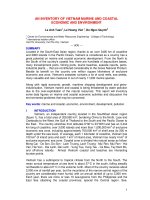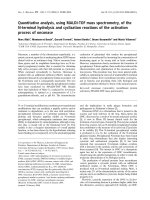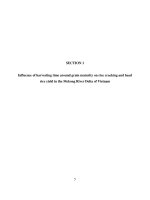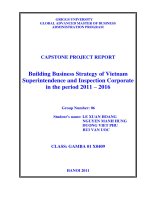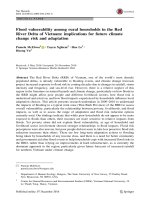The economic integration process of vietnam achievements and limitations
Bạn đang xem bản rút gọn của tài liệu. Xem và tải ngay bản đầy đủ của tài liệu tại đây (117.56 KB, 6 trang )
International Journal of Research in Management
International Journal of Research in Management
www.managementpaper.net
Online ISSN: 2664-8806; Print ISSN: 2664-8792
Received: 02-05-2019; Accepted: 04-06-2019
Volume 1; Issue 3; July 2019; Page No. 06-11
The economic integration process of Vietnam achievements and limitations
Nguyen Hoang Tien1, Boleslaw Rafal Kuc2
Lecturer and Researcher of Saigon International University, Faculty of Business Administration and Law, Ho Chi Minh City, Vietnam
2
Professor of Social Academy of Science in Warsaw, School of Management, Warsaw, Poland, EU
1
Abstract
In the current trend of globalization, international integration is the indispensable trend that countries choose and Vietnam too. This
article will help us to better understand the achievements and limitations of Vietnam in the process of economic integration. From the
use of secondary data sources collected from domestic and foreign agencies and methods of searching, researching, synthesizing and
concluding on the integration process of Vietnam. From that, we see the achievements and challenges that Vietnam faces in the present
and in the future. It proposes to promote the strengths of Vietnam to create more achievements in the future as well as engrave. Restricting
points makes it easy for Vietnam to face the challenges and difficulties of integrating into the world economy and becoming more and
more stable in the international arena.
Keywords: economic integration, achievements, limitations, Vietnam
Introduction
Economic integration with the global and regional economies has
recently accelerated in Vietnam. Vietnam became a member of
ASEAN in 1995, and joined the Asia-Pacific Economic
Cooperation (APEC) in 1998, while negotiating membership of
the World Trade Organization (WTO). Vietnam also signed a
bilateral trade agreement with the United States in 2000, and has
engaged in China-ASEAN free trade. Vietnam's integration into
the world economy began with "Doi Moi" in the late 1980s and
continues to this day. Integration is a key driver of socioeconomic development in Vietnam.
According to Miroslav N. Jovanovic and Foreword by Richard
G. Lipsey (1992) [13], International economic integration is one of
the means to increase welfare. With this arrangement, nations can
increase the welfare of one of the two integration groups, or some
of the countries in the group, or of the world in general.
Balassa (1973, p.1) defines economic integration as a process and
as a state of affairs. Maksimova (1976, p. 33) argues that
economic integration is a process of developing a profound and
stable relationship of division of labor between national
economies.
Holzman (1976, p. 59) states that economic integration is a price
situation of all similar goods and similar factors in two areas of
equilibrium.
Marer and Montias (1988, p. 156) indicate that economic
integration has traditionally been equated with the division of
labor in a regional geography, although it is often unclear to what
degree will justify the integration. Recently, economic
integration is believed to include the internationalization of
capital markets, labor, technology and entrepreneurship outside
the market for goods and services.
For Vietnam, the next five years will mark a milestone in
economic policy and development strategy. The report by the
Commission for Growth and Development presents an example
of 13 successful countries in economic development. with high
economic growth for a long time after World War II. Although
not in the list of 13 countries, Vietnam is considered an economy
with the potential to maintain high growth.
Vietnam's economy has grown rapidly and incomes have
increased sharply over the past two decades, but in the future the
economy may face more challenges. Over the past two decades,
Vietnam's economy has shifted its labor structure from lowproductivity agriculture to intensive labor-intensive processing.
The challenge in the future is how to put Vietnam up the ladder
in the value chain and even increase productivity. international
economic integration has become one of the important driving
forces for socio-economic development, strengthening the
national synergy; To promote the perfecting of the socialistoriented market economy; Expanding markets, boosting exports,
leveraging large capital resources, technology, knowledge,
management experience and other important resources; Create
more jobs. Vietnamese entrepreneurs have significant growth.
International economic integration together with efforts to reform
the investment and business environment, enhance the
competitiveness of the economy is gradually bringing Vietnam to
assert its position in the international arena and in the eyes of
Investors. The World Bank's 2018 Business Report predicts that
Vietnam will rank 68 out of 90 economies, up 14 degrees from
2017 (82/190 economies). Vietnam has also actively participated
in economic and financial organizations and trade agreements. In
addition, Vietnam continues to negotiate comprehensive regional
partnership agreements, the Comprehensive Partnership
Agreement and the Trans-Pacific Partnership. Up to now, about
60 economies have negotiated FTAs with Vietnam, including key
trading partners that hold about 90% of Vietnam's trade.
An important set of policy questions for Vietnam is how to
maintain high economic growth, both in the short run (before the
global economic downturn and financial markets), and in the long
6
International Journal of Research in Management
run (productivity growth and higher return on investment.
improve per capita income and continue to reduce poverty).
2. Theoretical Framework
What is the economic integration process? Over the years there
have been several attempts to define process integration. A study
of the most well-known definitions reveals that it has become
difficult to describe the fundamental principle behind process
integration.
In 1993 the International Energy Agency (IEA) defined
process integration as a systematic and general methods for
designing integrated production systems, ranging from
individual processes to total sites, with special emphasis on
the efficient use of energy and reducing environmental
effects (Gundersen, 2002), By this definition, process
integration is seen as a group of methods to optimize the use
of energy, but with concerns for environmental aspects.
In 1997 the IEA broadened their definition of process
integration to mean the application of methodologies
developed for system-oriented and integrated approaches to
industrial process plant design for both new and retrofit
applications (Gundersen, 1997). Along with this the
optimization of the system became a goal and a need for the
method’s applicability throughout the life cycle was
recognized.
Natural Resources Canada (2003) defined process
integration as all improvements made to process systems,
their constituent unit operations, and their interactions to
maximize the effective use of energy, water and raw
materials.
In the Finnish process integration technology program,
process integration was defined to mean: integrated and
system-oriented planning, operation and the optimization
and management of industrial processes (Timonen et al.,
2006) [23]. The operation and management aspects are
emphasized in the Finnish definition. The above definitions
describe the objectivity of a process integration task rather
than the principles through which the enhanced situation is
achieved.
Rossiter and Kumana (1995) [2] state that process integration
methods includes, focus on ensuring that existing process
technologies are selected and interconnected in the most
effective ways rather than attempting to invent new types of
equipment or unit operations. This definition slightly touches
the potential synergic effects which will be achieved by
integration.
According to the definition by El-Halwagi (1997) [12],
integration emphasizes the unity of the process. According
to him, “Process integration is a holistic approach to process
design, retrofitting, and operation which emphasizes the
unity of the process.
According to Ferenc Friedler, 2010, Process integration is a
family of methodologies for combining several processes to
reduce consumption of resources or harmful emissions to the
environment.
Economic integration, in the simplest and most common sense in
the world, is where economies are bound together. According to
this understanding, economic integration has taken place for
thousands of years and global economic integration has taken
place two thousand years ago when the Roman Empire invaded
the world and expanded its transport network, promote the
circulation of goods in the whole of their vast occupied territories
and impose their currency for the whole of the place.
Economic integration, in a more coherent way, is the institutional
link between economies. This concept has been proposed by Béla
Balassa since the 1960s and is accepted primarily in academia
and policy. To put it more clearly, economic integration is the
active process of simultaneously performing two things: on the
one hand, linking the economy and markets of each country to
the regional and world markets through open and promote the
liberalization of the national economy; on the other hand, join and
contribute to the building of regional and global economic
institutions.
In introductory courses on international economics, economic
integration is generally thought of as having six levels:
preferential trade area / agreement, free trade area / agreement,
customs union, the common market, monetary union, and
comprehensive integration. However, in practice, levels of
integration may be more and more diverse.
By Business Dictionary: Economic integration is an agreement
among countries in a geographic region to reduce and ultimately
remove, tariff and non-tariff barriers to the free flow of goods or
services and factors of production among each other; any type of
arrangement in which countries agree to coordinate their trade,
fiscal, and/or monetary policies are referred to as economic
integration. Obviously, there are many different stages of
integration.
Actually, there are many different interpretations and definitions
of the concept of "international integration". In general, there are
three main approaches:
The first approach, which belongs to the federalist class, is that
integration is a final product rather than a process. The product is
the formation of a federal state like the United States or
Switzerland. In evaluating association, those who follow this
school are primarily interested in the legal and institutional
aspects.
The second approach, with Karl W. Deutsch as a pillar, considers
integration first of all by linking nations through the development
of exchanges such as trade, investment, correspondence,
information, tourism , migration, culture, etc., from which the
security community gradually formed. According to Deutsch,
there are two types of security community: the unified security
community like the United States, and the multicultural security
community like Western Europe. Thus, this second approach
considers integration as both a process and as a final product.
The third approach considers integration as a phenomenon in
which countries extend and deepen cooperative relationships on
the basis of their intended intentional international labor division.
of each country and pursue goals.
3. Research Methodology
To study the economic integration process of Vietnam,
researchers have many different methods of research. The use of
secondary data collected from domestic and foreign agencies to
focus on the ASEAN Economic Community can be seen as
opportunities and challenges for Vietnamese enterprises (Tran
Van Hung, Le Thi Mai Huong, Nguyen Le Anh, 2015) [15].
Vietnam is an official member of ASEAN, APEC, ASEM and
WTO. The international economic integration, expanding trade
7
International Journal of Research in Management
relations with other countries and organizations is an opportunity
to make Vietnam become a country with developed economy and
this is also indispensable trend. . By statistical method, the top
500 fastest growing enterprises in Vietnam in the years 20082011, 2009-2012, 2010-2013, FDI enterprises have high growth
rate of double revenue. This is an important step for FDI
enterprises to promote economic growth in Vietnam (Hoang
Trung, 2015). Using the synthesis method, the author reviews
important achievements in international economic integration in
the last 30 years as well as summarizing the lessons for the
integration process of Vietnam in the path ahead. It shows that
the process of integration is constantly focused and promoted
(Nguyen The Binh, 2015) [15]. This paper is a case study and
research methodology used to study, synthesize and conclude
Viet Nam's integration process as well as its achievements and
challenges in the future.
4. Research Results and Findings
Achievements
During the last 30 years of the Innovation reform, from the 6th
Congress to the 12th Congress, the Party has put forth the right
policy in expanding international economic cooperation and
raising Vietnam's position in the international arena.
The biggest event was Vietnam's accession to the World Trade
Organization (WTO) in January 2007, marking Vietnam's
comprehensive integration into the world economy. In May 2008,
a comprehensive strategic cooperation partnership was signed
between Vietnam and China. From 10/2015, is one of the
members involved in the negotiation of the Trans-Pacific
Strategic Economic Partnership (TPP). Vietnam has made more
transparent economic reforms and more liberal economic policy
reforms, contributing significantly to the development of a
socialist-oriented market economy. Vietnam. Through
international economic integration, it has created opportunities
for Vietnam to access the achievements of science and
technology in the world, step by step bringing the activities of
enterprises and the economy into the competitive environment. .
Vietnamese enterprises have the opportunity to receive a lot of
experiences in modern production management through joint
venture projects with foreign partners. Many modern
technologies, advanced production lines are used to create new
developments in the manufacturing industry.
International economic integration forces Vietnamese enterprises
to compete in both domestic and foreign markets. Therefore,
enterprises must constantly innovate their technology, improve
management efficiency, improve productivity and quality, focus
on branding to survive and develop. At present, many items of
our country are evaluated as competitive in the international
market. Some companies have invested overseas such as Viettel,
PetroVietnam, Hoang Anh Gia Lai, Trung Nguyen Legend
Coffee, Vinamilk, etc. The overseas markets are Laos, Russia,
Singapore, Cambodia, UK, Taiwan.
In line with the trend of establishing free trade areas in the world,
Vietnam has established diplomatic relations with more than 170
countries in the world, expanding trade and exports to over 230
markets of countries and territories, signed on 90 bilateral trade
agreements, nearly 60 agreements on investment promotion and
protection, 54 agreements on double taxation, 12 trade
agreements By (FTA) with 56 countries and economies in the
world, of which 6 FTAs are actively participating outside of
ASEAN framework or with ASEAN partner countries and many
cultural cooperation agreements. with foreign countries and
international organizations
Viet Nam has also actively participated in negotiating the
Comprehensive Economic Partnership Agreement (RCEP) in
order to reach a comprehensive economic agreement in line with
the conditions of Vietnam and ASEAN countries. Vietnam
officially joined the ASEAN Economic Community and
successfully completed the rotating ASEAN Presidency in 2010.
In 2011, Vietnam has actively participated in programs to
implement the Community ASEAN by 2015. With the active
implementation of priority measures to implement the AEC
Master Plan, Vietnam is considered one of the member countries
with the highest implementation rates of measures in the AEC.
Foreign economic relations in particular and international
economic integration in general have contributed significantly to
the socio-economic development of the country, opening up new
development space for the Vietnamese economy, deepening
relations with countries in the region and the world, raising the
position of Vietnam in the international arena. At the same time,
creating opportunities for Vietnam to implement a strategy to
restructure export markets in a more balanced way, promote
reforms and restructure the economy, strengthen the
competitiveness of enterprises and the economy. Specifically: the
number of export markets has increased more than 1.4 times in
10 years, from 160 markets to over 230 markets. The structure of
export and import markets has shifted towards gradually reducing
dependence on Asian markets.
Since then, it has had a great impact on the growth, contributing
to promoting socio-economic development, enhancing
production capacity and expanding the market in a number of
fields such as industry, trade and services. To promote economic
restructuring, to shift the production structure in a positive way,
in line with the modern industrialization policy, thereby focusing
more on processing and manufacturing goods to gain higher
value and content of technology and added value; Promote trade,
increase attractiveness of foreign investment and expand
cooperation and development.
To create positive effects, promote the reform and perfect the
market economy mechanism and improve the business
environment, thus contributing to raising the competitiveness of
our economy in the long run, creating the environment. Business
is increasingly equal, transparent, predictable and increasingly in
line with international standards and practices. Vietnamese
enterprises have the opportunity to participate in the value chain
and regional production network, shift the production structure
towards a positive direction, focusing more on the processing and
manufacturing products of higher value added and technology
content.
In terms of contributing to strengthen the political system security - national defense of Vietnam, international economic
integration has strengthened the political system, enhanced the
prestige and role of the Party and the State, and strengthened its
position and international role. On the other hand, international
economic integration creates the foundation for ensuring national
security and defense and creating better conditions for the
implementation of social programs such as hunger elimination
and poverty alleviation and development of remote areas
8
International Journal of Research in Management
Limitations
However, the process of economic integration also helps Vietnam
to recognize the limitations and challenges it faced:
Firstly, the guidelines, policies and policies of the Party and State
law on international economic integration are slow to be
reformed compared with the requirement of expanding external
relations, international integration, and incomplete integration.
Enough and taken seriously. International economic integration
is also affected by one-way, short-term and local approaches.
Therefore, not fully utilize the opportunities and respond
effectively to the challenges. In relations with other countries, we
are passive, have not built up mutually beneficial relations,
depending on each other with countries.
Secondly, in some cases, international economic integration is
passive, fascinated by the situation and political demands, there
is no scientific and practical basis for research while the degree
of readiness And the preparation of our economy is not high.
Thirdly, international economic integration is not closely linked
to the requirements of improving efficiency, sustainable
development, protecting political security and social order and
safety, preserving and promoting cultural identity of the nation.
It has not been synchronized with the process of increasing
linkage between regions and areas throughout the country. The
mechanism of directing, managing, supervising and coordinating
the process of integration, from the central to local levels,
between branches and sectors still faces many shortcomings.
Fourth, the enterprises in our country are mostly small scale,
weak in management and technology. In the field of industrial
production, the level of equipment is backward, the infrastructure
is poor. In addition, human resources in general and external
staffs have not basically met the demand in both quantity and
quality. Awareness of international law, business technology in
business management is limited.
5. Discussion
Viet Nam is actively implementing the Revolution 4.0 to build a
digital economy and civilized society. The emergence and
development of a market economy is also the driving force
behind the integration process. Integration has become a major
trend of the modern world, strongly affecting the international
relations and life of each country. In particular, the biggest event
was Vietnam's accession to the World Trade Organization
(WTO) in January 2007, marking Vietnam's comprehensive
integration into the world economy. With its accession to the
WTO, Vietnam has made more progressive reforms of its
economic, trade and investment policies towards greater
transparency and liberalization, contributing significantly to the
development of a market economy with socialist orientation in
Vietnam. In the context that our country is "actively and actively
integrating into the world" in the spirit of the Resolution of the
XIth National Party Congress, the determination of the right
meaning, nature, implication and movement as well as The
implications of international integration are very important and
important in developing our country's strategies, policies and
measures. In general, there are three main approaches: The first
approach, which belongs to the federalist school, is that
integration is a final product rather than a process. The product is
the formation of a federal state like the United States or
Switzerland. To assess association, they are primarily interested
in the legal and institutional aspects. The second approach, with
Karl W. Deutsch as the pillar, see integration first of all by linking
nations through the development of exchanges such as
commerce, investment, correspondence, etc. gradually the
security community. The third approach considers integration as
a phenomenon in which countries extend and deepen cooperative
relationships on the basis of their intended intentional
international labor division. of each country and pursue goals. In
Vietnam, the term 'international economic integration' began to
be used in the mid-1990s, in conjunction with the process of
Vietnam's accession to ASEAN, joining the ASEAN Free Trade
Area (AFTA) other international economic. In addition, the
signing of two Agreements and the conclusion of two important
agreements, TPP and Vietnam-EU, will have a significant impact
on Vietnam's economy in the coming period. Specifically: For
export and import: The process of implementing tariff reduction
commitments in international economic integration, improving
the customs management system according to international
standards and reducing the tariff barriers, posing a positive
impact on Vietnam's export and import activities. Regarding the
restructuring of export of industrial goods, the international
economic integration has pushed up the economic restructuring,
especially the restructuring of export goods production in a
positive and suitable manner. Industrialization is more modern,
with more focus on value-added processing and manufacturing,
and higher technology and value added. For FDI attraction: In
Vietnam, investors can access and enjoy preferential tariffs from
big markets that Vietnam has signed FTAs such as ASEAN,
China, Korea and India. In addition, the implementation of
commitments in new generation agreements such as TPP and
EVFTA will make the investment environment in Vietnam more
open, transparent and more favorable, attract more investment
capital. For state revenues: The tariff reduction path in FTAs will
lead to a reduction in state budget revenues for imported goods.
However, the impact of tax reduction on total state budget
revenues is not substantial. Overall, international economic
integration has been providing many opportunities for businesses
and the economy of Vietnam. However, with 96% of total
operating enterprises being small and micro enterprises,
competitive pressure on the Vietnamese economy is very high.
For domestic production: The liberalization of import tariffs will
lead to a rapid increase in imports from other countries, especially
from TPP countries, EU countries in Vietnam due to cheaper
prices, quality and diversified designs will impact on domestic
production. In addition, when tariff barriers are removed,
Vietnam will become a market for low-quality products that
affect consumers' health. For the investment sector, the increase
in foreign capital inflows into Vietnam also calls for
strengthening the capacity of regulatory authorities to monitor
capital inflows, avoiding the risk of bubbles or capital outflows
so that the economy can absorb the capital effectively. On the
contrary, integration also puts many countries ahead of many
disadvantages and challenges, in particular: integration increases
the fierce competition that many businesses and industries have
difficulty, even bankrupt, resulting in socio-economic
consequences; integration increases the dependence of the
national economy on the external market, thus making the
economy vulnerable to fluctuations in international markets; do
not distribute benefits and risks fairly to different countries and
groups in society, thereby increasing the gap between rich and
poor; In the process of integration, developing countries face the
9
International Journal of Research in Management
risk of adverse natural economic shifts due to their tendency to
focus on resource intensive, labor-intensive sectors. As a result,
they are becoming low-tech and industrial landfills, depleting
natural resources and destroying the environment; Integration can
put countries at increased risk of international terrorism,
smuggling, transnational crimes, epidemics, illegal immigration
6. Conclusion and Recommendation
International integration is an inevitable process of development,
due to the social nature of labor and the interpersonal relationship.
Integration takes place in many forms, levels and in many
different areas, from low to high. Today, international integration
is the policy choice of most nations to develop. Implementing the
policy of international economic integration of the Party, our
country has step by step actively integrating into the regional and
world economy. Achievements in international economic
integration have contributed significantly to the socio-economic
development of the country, enhancing Vietnam's position and
role in the international arena. Over time, Vietnam has achieved
many achievements in integration, it has become a country with
high position in the region and it has participated in all major
international organizations such as the United Nations; WTO;
ASEAN, ASEM, and APEC, and signs bilateral free trade
agreements with partners in the region and in the world. The
process of international integration, first and foremost
international economic integration in recent years, has enabled
Vietnam to effectively attract all three major international
resources: Official Development Assistance (ODA) foreign
direct investment (FDI) and remittances. Participating in
international integration, import-export activities of Vietnam has
been developing strongly, constantly growing in both size and
speed. Vietnam's imports and exports have become a major driver
of the national economy. The process of international integration
has contributed to the training of Vietnamese managers,
businessmen and qualified human resources, both in terms of
expertise and management. At the same time, international
integration also accelerates the process of administrative reform
and reforms of the market economy, facilitating foreign partners
to do business with Vietnam. The Government should actively
and actively participate in negotiating bilateral and multilateral
trade and investment agreements in the framework of WTO,
APEC, ASEAN, ASEM, etc. This will create more favorable
conditions for Vietnam's trade and investment to mobilize all
resources to successfully implement three strategic
breakthroughs: institutional reform; infrastructure development;
human resource development. In order to develop external
economic activities in international integration, it is essential that
the country has a synchronous and modern infrastructure. In order
to mobilize all resources for successful infrastructure
development, it is necessary to implement transparency and
simplification of investment procedures, to strengthen checks and
controls on borrowing and use of loans in an effective way.
Resolutely fight against waste and corruption to regain
confidence in the Government of domestic and foreign investors.
The low quality of human resources is not only determined by the
education and training system but also depends on the mechanism
of human resource use. Therefore, it is necessary to reform the
mechanism of using and treating talents in the direction of using
and rewarding people who are real and not just based on their
qualifications. The government should continue to implement
policies to stabilize the macro economy and improve the
production and business environment to attract domestic and
foreign investment in the production of goods and services and
promote exports to the regional and world markets. Policies to
promote import-export activities in integration: The Government
should implement policies within the framework of trade
agreements to allow enterprises to participate in the chain of
goods and services for export purposes. To organize the
production of key export goods and services and develop export
markets. Simultaneously, the anti-dumping, anti-subsidy law
within the WTO's framework should be rapidly improved to
protect the domestic market from the entry of foreign goods in
the implementation of international trade agreements. The
government needs to further improve its investment environment
to attract more (direct and indirect) foreign investment into
Vietnam. In the immediate future, for direct investment, it is
necessary to adopt policies to attract investment in hi-tech
industries, biotechnology, electronic technology, information and
communication technologies, etc. To attract foreign direct
investment In addition to the development of the stock market,
the Government should quickly expand to foreign investors,
including banking and insurance.
7. References
1. Acharya Amitav. Regionalism and Regime Security in the
Third World: Comparing the Origins of ASEAN and the
GCC” trong Brian L. Job (ed.), The Insecurity Dilemma:
National Security of Third World States, Boulder, Lynne
Rienner, 1992.
2. Alan Rossiter P, Jimmy Kumana D. Pollution Prevention and
Process Integration – Two Complementary Philosophies, in
Waste Minimization through Process Design, A. P. Rossiter
(ed.), McGraw-Hill, New York, 1995, 43-49.
3. Abbott P, Bentzen J, Tarp F. Trade and Development:
Lessons from Vietnam’s Past Trade Agreements. World
Development. 2009; 37(2):341-353.
4. Davis GD. Regional Trade Agreements and Foreign Direct
Investment. Politics & Policy. 2011; 39(3):401-419
5. Danthine JP, Hunt J. Wage bargaining structure,
employment and economic integration. Economic Journal.
1994; 104(424):528. doi: 10.2307 / 2234629.
6. Doanh NK. Impacts of Trade Liberalisation Commitments
on the Vietnamese Economy: A CGE Approach. World
Economy. 2009; 32(4):606–628.
7. Ferenc Friedler, Process Integration, Modelling and
Optimisation for Energy Saving and Pollution Reduction,
Applied Thermal Engineering. 2010; 30(16):2270-2280.
8. Grinter LE. Vietnam’s Thrust into Globalization:
Innovation’s Long Road. Asian Affairs: An American
Review. 2006; 33(3):151-166.
9. Hoàng Trung, Hội nhập kinh tế quốc tế: Cơ hội và thách thức
tăng trưởng, Vietnamnet, 2015.
10. John Campbell Y, Andrew W Lo, and A. Craig MacKinlay.
The Econometrics of Financial Markets.
11. Jean-Pierre Cling, Mohamed Ali Marouani, Mireille
Razafindrakoto, Anne-Sophie Robilliard, Franỗois Roubaud.
Vietnams Terms of accession and Distributional Impact of
WTO Membership, 2008.
12. Mahmoud M. El-Halwagi, Process Integration, Process
Systems Engineering, Elsevier Inc., 2006.
10
International Journal of Research in Management
13. Miroslav N. Jovanovic and Foreword by Richard G. Lipsey.
International Economic Integration Limits and Prospects,
1992.
14. Nguyen Van Trinh and Tran Huy Hieu. International
integration - achievements, limitations and solutions to
promote international integration.
15. Nguyen The Binh, 30 years of Vietnam's international
economic integration: Achievements, challenges and
lessons, Development and Integration Magazine. 2007-2015.
16. Nguyen Tien Dung. Impacts of East Asian Integration on
Vietnam: A CGE Analysis. Lecturer, Faculty of International
Economics College of Economics, Vietnam National
University, Hanoi.
17. Raskovic P. Process integration approach for energy saving
and pollution prevention in industrial plants, Faculty of
Technology Engineering, Leskovac, Serbia, 2007.
18. Prema-chandra Athukorala. Economic Transition and Export
Performance in Vietnam. ASEAN Economic Bulletin, Vol.
26, No. 1, Vietnam: Coping with Domestic and External
Challenges, 2009, 96-114.
19. Pham Quoc Tru. Actual situation of international economic
integration of Vietnam in recent years and prospects of
coming years, International Research Journal No. 1 (80) in
2010.
20. Pham Thanh Ha. International integration of Vietnam - the
process of cognitive development, practical achievements
and a number of requirements. Ho Chi Minh City National
Political Academy - Regional Political Academy I.
21. Rivera-Batiz LA, Romer PM. Economic Integration and
Endogenous Growth. The Quarterly Journal of Economics.
1991; 106(2):531.
22. Sebastian Braun. Economic Integration, Process and Product
Innovation, and Relative Skill Demand. Review of
International Economics. 2008; 16(5):864-873.
23. Timonen J, Antikainen M, Huuhka P. Competitiveness
Through Integration in Process Industry Communication.
Evaluation report. Technology programme report 11/2006.
National Technology Agency of Finland (TEKES). Helsinki,
2006.
24. Trinh Thi Tuyet Mai. Economic function of the state in the
market economy in Vietnam today. Hanoi, 2009.
25. Tran Van Hung, Le Thi Mai Huong, Nguyen Le Anh, Journal
of Development & Integration. 2015; 20:30.
26. Ministry of Foreign Affairs, Vietnam integrates economy
into globalization trend: Problems and solutions, National
Political Publishing House, Hanoi, 2002.
27. VOV.vn, Diplomacy contributes to creating the core value
for Vietnamese trade, < [Accessed September 6, 2018]
28. East Sea Research, International Integration: Some
theoretical
and
practical
issues
< enter-national-a-number-van-de-lyluan-and-thucien-money> [Accessed September 6, 2018]
29. Financial magazine, Impact of international economic
integration
on
Vietnam's
economy
< />-course-in-business-international-
30.
31.
32.
33.
business-in-business-vietnam-86147.html>
[Accessed
September 6, 2018]
Vietnam's international economic integration and measures
< [ Accessed October 15, 2018]
Key milestones in Vietnam's international economic
integration process
< />[Accessed October 15 2018]
11
